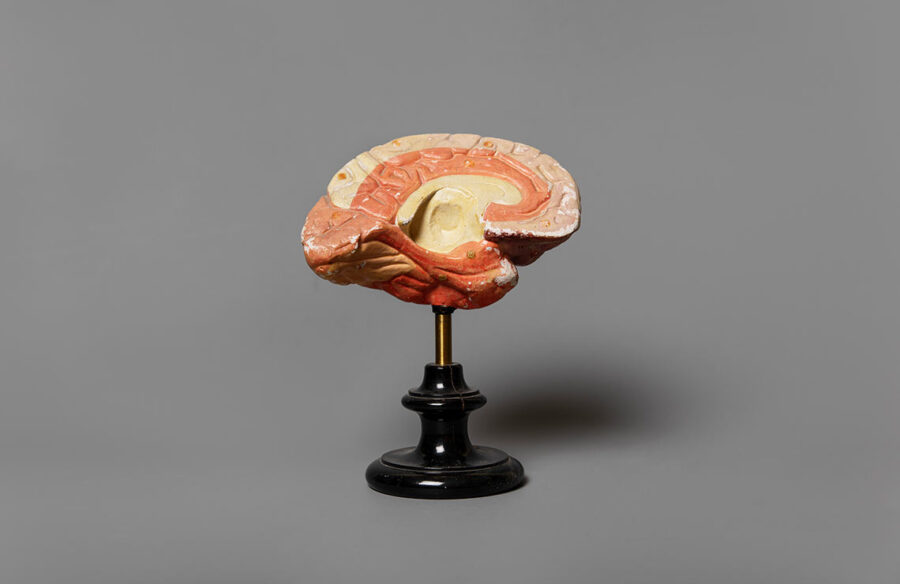
Reading minds and saving lives
We are entering a new era of medicine, where AI will revolutionise healthcare and treatment. It might also lead to more empathetic doctors.
Pancho was 20 years old when he was paralysed and lost his ability to speak. He was a Mexican-born amateur football player and a field worker in the California vineyards, until one summer Sunday after a match, he was in a car crash. After surgery, he suffered a stroke and his life changed.
When he woke up from his coma, he tried to move. He couldn’t. He tried to talk and discovered he couldn’t form a word. Then he started to cry, but he couldn’t make a sound.
At that point he wished he hadn’t come back from the coma at all, he recently told a New York Times reporter. Pancho felt like his life was over.
Today Pancho can speak again
Fifteen years later, his life would change again, when a group of American scientists implanted a chip with 128 electrodes into his brain, plugged a cable into his skull and trained deep learning software to read his mind. Today, Pancho can speak again. When he thinks of words, the software decodes the signals from his brain and his words are spoken in a gravelly, synthetic voice.
Interpreting his brain signals and translating them into words is only possible thanks to an artificial neural network interacting with Pancho’s organic one. The AI software was trained on his thoughts during 50 sessions in which Pancho was trying to speak words, until it recognised the patterns of brain signals that corresponded to certain words. (Thanks to his new ability to speak, the patient has expressed that Pancho is the nickname he prefers, to protect his privacy.)
Pancho’s AI-assisted rehabilitation may seem like the stuff of science fiction. It is all the more remarkable for being real, and part of an AI revolution in medicine and health care.
The AI research field was conceived at Dartmouth College in 1956, a year when James Dean ruled the silver screen and Elvis Presley had his first number one hit, Heartbreak Hotel. Since then, AI has had its ups and downs, exaggerated expectations followed by troughs of disillusionment. The term “AI winter” was coined specifically to denote periods of disenchantment, when investment in AI dried out and the pace of progress slowed.
Notably, AI systems have defeated humans at games like go, Dota and Jeopardy.
Since Pancho’s accident in 2003, however, AI has made great strides thanks to the advent of artificial neural networks. The theory behind it had been established decades earlier, the idea that software networks mimicking the arrangement of neurons in the human brain would provide an important step in the evolution of thinking computers. But it wasn’t until the 2000s that it bore fruit, when processor speeds, storage capacity and data availability finally reached a tipping point in which it became feasible to train large neural networks on vast amounts of data, quickly leading to improvements in image recognition, automatic translation, and other domains.
Notably, AI systems have defeated humans at games like go, Dota and Jeopardy. Social media corporations have used machine learning to find the best methods to keep us refreshing our feeds in endless loops of distraction, and self-driving cars are inching ever closer to arriving on our streets. But only in the last few years has medical AI started taking off in a big way. And if you think hooking a cable to Pancho’s skull and reading his mind is something of a miracle, well, that’s just the tip of the iceberg.
Alphabet’s AI research company Deepmind is perhaps best known to the public for creating Alphago, the go-playing AI that runs circles around human go masters. But their work on Alphago has turned out to be useful in another domain as well. In 2020, Deepmind entered their tweaked AI, Alphafold, in a contest to solve the problem of protein folding. To nobody’s surprise, Alphafold crushed the competition.
Mapped out proteins of the Corona virus
Biologists have hailed Alphafold’s success as the first time AI has solved a significant scientific problem. An improved understanding of protein folding is already significantly reducing development timelines for drugs and vaccines. For instance, during the Covid-19 pandemic, Alphafold’s predictions were used to map out the proteins of the virus.
Currently, AlphaFold is being used to help develop new drugs for tropical diseases. It has already helped scientists find a safe drug for treating sleeping sickness, replacing a previous drug that is highly toxic.
Other areas where AI is currently being used include:
Medical imaging
Interpretation of visual data is key in fields such as dermatology and radiology, and fertile ground for machine learning algorithms. Tech companies, hospitals and universities around the world have developed machine learning algorithms that surpass human experts at detection of various skin conditions, cancers and other abnormalities. While human specialists can be highly skilled at examining rashes and reading x-ray plates, they require years of training and they are a scarce resource. AI speeds up the process, makes these skills more accessible and can, in some cases, detect anomalies that human doctors cannot.
Health records analysis
Electronic health records create new opportunities for machine learning algorithms to find previously unknown patterns in symptoms, diagnoses, medications and treatment effects. Researchers in Uruguay have developed a system that analyses the text a doctor enters in a health record and pulls up similar cases that may contain valuable insights. Spanish researchers have created a system that analyses a patient’s health record, and predicts risks for diseases based on their historical data along with data from their family’s health records. As health record data grows at a rapid pace, human physicians cannot keep up, but they can learn from the analysis performed by AI systems.
Diagnosis
Symbolic AI was first tailored to diagnose disease in the 1970s, using rules-based decision trees to create “expert systems” to assist professionals in their decision making. Recent methods instead rely on artificial neural networks and have proven themselves useful in diagnosing a vast range of diseases, relying on techniques such as image recognition, symptom evaluation and natural language processing.
Disease control
On December 31, 2019, the Canadian medtech company Blue Dot alerted its clients about a new flu-like virus spreading in Wuhan, China. They were a week ahead of the World Health Organisation and the Centers for Disease Control, thanks to their use of machine learning algorithms that were processing 100,000 news items and disease reports in 65 languages every day. AI-supported systems such as the Blue Dot platform can monitor the spread of new diseases, but also predict future trajectory based on data such as travel patterns, hospital admittance, historical data from previous epidemics and mathematical models.
Drug interactions
For patients taking a large number of medications, drug interactions can be potentially harmful as well as hard to track by individual physicians. Spanish and Chinese researchers have shown that machine learning algorithms can scan databases, medical literature and electronic health records and find patterns indicating adverse reactions to drug combinations.
Drug discovery
AI has proven its ability to speed up drug discovery dramatically. It is useful in several ways, such as predicting the 3D structure of target proteins, predicting drug-protein interactions and toxicity risks, designing biospecific drug molecules as well as assessing drug activity. While Deepmind has turned its attention to neglected tropical diseases, British medtec start-up Exscientia and Japanese pharmaceutical firm Sumitomo Dainippon Pharma used AI to create a treatment for obsessive-compulsive disorder. Development took only twelve months (compared to the expected timeline of five years) and the drug is now in human trials. Many other research teams around the world are currently using AI to find new drugs, and Andrew Hopkins, CEO of Exscientia, recently predicted that all new drugs will be created with the help of AI by 2030.
Neural prosthetics
With machine learning, Swiss researchers have trained algorithms to interpret the muscle signals of an amputee, to control a prosthetic hand. The task is complex because muscle signals are noisy and traditional approaches have yielded clumsy results. Machine learning changes the game, and the AI-powered prosthetic is more precise and quicker to react than previous prostheses. Advances in this field are bearing fruit in many research labs and Pancho’s new ability to talk is another example of this approach, called a speech neuroprosthesis.
As Pancho’s example and all the ongoing research demonstrates, we are entering a new era of medicine where machines can read the signals of our bodies, unfold amino acid molecules, replace lost abilities and tailor drugs to the protein structure of specific viruses. There will be disputes over privacy and security, as AI systems crave massive amounts of data to further increase their capabilities. But the technology is so powerful and the stakes are literally life and death. As evidence of AI’s potential continues to grow, odds are that privacy advocates will be fighting a lost cause. After all, no government would prioritise privacy over a cure for cancer or prevention of the next pandemic.
Humans doctors can relate
Will friendly and competent doctors be replaced then, by robodocs with superior diagnostic skills and knowledge of drug interactions? Well, not so fast. If there is one domain where humans are irreplaceable, it’s emotional work. No algorithm will feel genuinely sympathetic about your knee pain. If you want cold, hard facts, go see Dr Alphacure. If you want someone who can relate to your problems, go see someone made of the same stuff as you: flesh, blood, bone.
Sometimes, you see your doctor just to get your prescription renewed. But often, when you go because of a new ailment or injury, you are not only hoping for an intelligent analysis of your symptoms. You want to be taken care of, by someone who understands – from the inside – what it is to have your body starting to fail. You want someone who knows what it is like to wake up at 4 a.m., chest pounding, fearing that your expanding mole might be a mark of death. In time, AI could be taught to simulate these emotional skills. But fake empathy, in the end, is just manipulation.
While human expertise can be replaced by AI, empathy cannot. But as AI unburdens medical practitioners from many of the mechanical tasks of the profession, physicians may have greater opportunity to develop their human-to-human skills. In this way, medtech AI will not only revolutionise drug research, give voice to the speechless and improve diagnostic accuracy. It may just lead to more empathetic doctors, too.

Sam Sundberg
Freelance writer, Svenska Dagbladet
Years in Schibsted: 2.5

